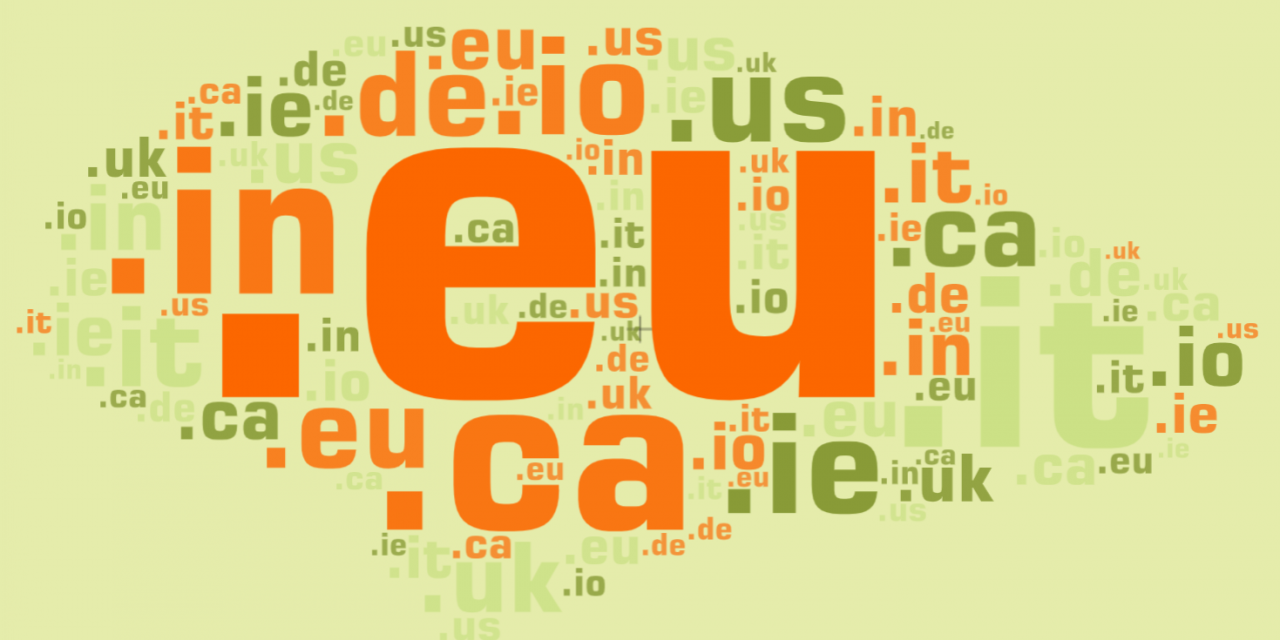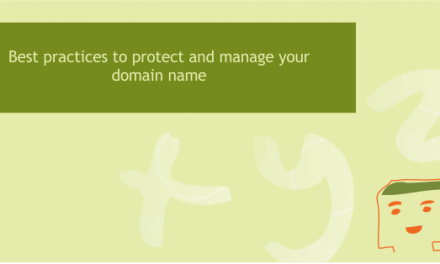Although they are often overshadowed by generic TLDs (.com, .net, .xyz, etc), ccTLDs have always been available to provide a more targeted and local extension for your website domain name.
What are ccTLDs?
A country code top-level domain (ccTLD) indicates that your website is geared towards a particular geographic regions or country. For example, .us is for the United States, .uk – for the United Kingdom, .ch for Switzerland, etc. The Internet Assigned Numbers Authority (IANA) functions as the governing body that maintains technical standards that help run the Internet – publishes a domain list of ccTLDs available.
Benefits of ccTLDs over gTLDs
There are several advantages to picking a ccTLD (country code top-level domain) over a generic domain name. If you are looking to target a local market, then consider going with a ccTLD too in order to coordinate your online marketing efforts.
Thanks to their local nature, country code TLDs boast a number of local market advantages over global domain extensions, these advantages are as follows:
1. Improve local SEO and secure a top search position in local searches
Search engines like Google always try to serve content that is relevant to users. Along with showing sites located in the country of the user, they also give priority to websites using ccTLDs.
This ties into your Search Engine Optimization (SEO) value as well. Using a ccTLD gives you a higher SEO value for country-based search results. This is because search engines return different results, including many local ones, depending on the IP address of the person doing the search.
This is because a country domain is recognized by Google as the clearest sign of what country/region a website is targeting.
That said, ccTLDs are the most powerful way to rank a website in a certain country organically.
2. They target local markets easily
Websites using their local country-code extension are approached with more confidence and trust by local markets. With the help of ccTLDs, you can target specific markets even if you are not physically located there. If you are running an international business and are operating in a completely different country, you could easily target that country’s local market by registering your site under the corresponding ccTLD.
For instance, by using .de ccTLD you could target customers from Germany, without being there physically.
2. Inspire loyalty and trust in your website visitors
A domain name on a given country-code extension makes prospects from that country feel safer to make purchases. ccTLDs are good for credibility and they give visitors to your website more confidence. Since they consider the website to be local, visitors may feel that it’s easier to make purchases, especially if they see that the address is somewhere that they recognize rather than a foreign address. Also, many people prefer to complete transactions and visit sites in their own currency, and region. The national aura that a ccTLD adds to a site may cater to users’ patriotism and make them feel proud they support a website that they share the same culture and language with.
4. Domain name hacks to getting the name you want
Short, memorable and SEO-friendly domain names are usually already taken with global TLDs such as .com or .net. And even if they are available, they are usually offered at an unreasonably high price (these are known as “premium domains”).
A clever trick that some companies have been using to build a strong brand around their domain name is using what’s known as a domain hack. This is when a word or name is formed using both the domain name and ccTLD together. For example, mov.ie uses the Ireland ccTLD, and press.in uses the Indian ccTLD. It can even be a phrase or call to action like check.in or save.us. There really are no limits to the variety of combinations you can come up with! Keep in mind that Thexyz offers all of the above ccTLDs, making it easy for you to come up with your very own creative domain hack.
5. Creative registry operator campaigns to promote ccTLDs
Almost every single country or region in the world has its own ccTLD assigned to the domain names system. This means there are hundreds of registries that are taking care of ccTLD management. Each of these companies has their own tactics and strategies to bring generic top level domains to the attention of the public and to raise awareness about their local market benefits over the generic TLD choices. Some of the registries stand out from the crowd due to their creativity and enthusiasm in popularizing country code top level domains (ccTLDs) .
We’ve compiled a list of the top creative registries for you:
🍁 Canada: .CA domains
CIRA – the registry behind .ca – the official ccTLD for Canada, has launched an active ad campaign that plays on a sense of patriotism and national responsibility.
Their website is targeting Canadian individuals and businesses with a special message – choosing a .CA domain is a question of national pride. Unlike other IDN ccTLDs, CIRA offers all registrants the choice of using a their own DNS service. This allows CIRA to not only be the registry, but also the DNS root host.
Moreover, the preference of .ca over the generic top-choice TLDs such as .COM and .NET testify their engagement with Canada. Another benefit to .CA domains is that they come with free domain privacy protection. This allows the required contact information for technical and administrative contacts on the domain to be masked and private.
In 2012, CIRA introduced support for the latin alphabet and a full range of French accented characters in .CA domain names: é, ë, ê, è, â, à, æ, ô, œ, ù, û, ü, ç, î, ï, ÿ. When a .CA is registered, all variations of a domain name with these Latin characters are reserved for the registrant and cannot be registered by anyone else.
.CA domain registration requirements
To purchase this ccTLD, you must meet the requirements of CIRA. These requirements include but are not limited to being one of the following: a Canadian citizen or permanent resident, Canadian corporation, association, educational institution or trademark.
Happy International Internet Day! As you may know, we think the internet is kind of a big deal.
— CIRA (@ciranews) October 29, 2020
Here are a few of the things we do to support the internet in Canada.#InternetDay #InternationalInternetDay pic.twitter.com/ACENny4VDK
📢Canada's Internet Factbook 2020 is now live!
— CIRA (@ciranews) July 16, 2020
Highlights:
- 41% say Facebook is the most toxic site they use
- 11% say they're addicted to the internet
- 70% say please & thank you to their voice-activated assistant.
More at https://t.co/MLDiKC3smf#internetfactbook 🇨🇦🖥️📕 pic.twitter.com/tDgJRYv8v7
☘️ Ireland: .IE domains
IEDR – the registry behind the official ccTLD for Ireland – .ie, has been very active over the years in providing a secure, reliable, and reputable namespace for Irish entities.
Through a strict registration procedure, they aim to show the registrants how much they care about privacy and security.
Also, they have been working actively with Irish SMEs through various educational and contest campaigns to help them with their online initiatives.
This way, they’ve turned their registrants into real ambassadors of the .ie namespace:
Through their annual SME Digital Health report, IEDR analyzes and measures the Irish SME’s digital skills in several categories such as online communication with customers, ease of transaction, and online growth.
By awarding an overall grade to SMEs, IEDR encourages them to improve their digital skills and increase e-commerce adoption on the Irish market.
.IE domain registration requirements
Since the registry for .IE domains have dropped restrictions, purchasing the ccTLD of Ireland requires that you meet the IEDR requirements which include being located in the 32 counties of Ireland or providing proof of a connection to the country, such as trade and/or commercial activity.
How to use your .ie: A branded #email which matches your website gives the right first impression that you are an established, trustworthy business and helps to develop your brand consistency. Read more ➡️ https://t.co/0EvK7K2TVf pic.twitter.com/TslvN04sOS
— .IE (@dot_IE) December 9, 2020
With a .ie online address, consumers know they can trust your business. Every .ie applicant's identity is checked and validated at the point of registration. Find out how to register your .ie - it's easy and fast ➡️ https://t.co/8AuErHtnK5 #ChooseIE pic.twitter.com/dh8uZCCD4X
— .IE (@dot_IE) December 10, 2020
🍕 Italy: .IT domains
Registro.it – the registry in charge of .it – Italy’s domain extension, has invested creativity and effort in developing an educational animated web series called “What a digital world”.
It is dedicated to the digital challenges that change society and offers Italian individuals and businesses a simple, concise, and fun explanation of various topics they are directly involved in such as cybersecurity, artificial intelligence, and digital identity.
| New active .IT registrations | |
|---|---|
| 2020 | 578,545 |
| 2019 | 577,328 |
| 2018 | 518,887 |
| 2017 | 506,515 |
| 2016 | 513,101 |
| 2015 | 503,116 |
| 2014 | 491,365 |
| 2013 | 494,195 |
| 2012 | 498,788 |
| 2011 | 502,653 |
| 2010 | 519,730 |
| 2009 | 442,058 |
| 2008 | 339,357 |
.IT domain registration requirements
When you place an order for a .IT domain, you need to complete the following additional fields in the Registrant Contact Information section of the order form:
- Entity Type — From the drop-down list, choose the category that best describes the Registrant:
- Persons, Foreign and Italian
- Italian Companies/One Man Companies
- Italian Freelance Worker/Professionals
- Italian Non-profit Organizations
- Italian Other subjects
- Non Italian, Non Persons
- Nationality — This field is required if Entity Type is Persons, Foreign and Italian. From the drop-down list, choose the Registrant’s nationality. The Registrant must be either resident of an EU nation or a citizen of an EU country. For example, a French citizen living in the U.S. can buy a .IT domain (Nationality=France, Country=United States), and a U.S. citizen living in France can also buy a .IT domain (Nationality=United States, Country=France), but an American living in the U.S. cannot buy a .IT domain.
🛕 India: .IN domains
.IN registry – .IN is a natural extension for your Indian business
.IN registry – the registry behind India’s official ccTLD – .in, has taken a fun approach to promoting .IN via the power of video content.
They have invited .IN website owners to take part in their #IamIN video series which presents the advantages of owning a .IN domain in a convincing, real-life manner:
.IN domain registration requirements
There are no special requirements for registering a .IN domain name.
Dot in (.IN) sites rank higher in Google search results in India. So, what are you waiting for? Book your .IN domain name today at - https://t.co/GHzeMjqJGk #IamIN #DotIN #wednesdaymorning #WednesdayWisdom #NewIndia #OnlineBusiness #DigitalIndia #WednesdayThoughts #BeDotIN pic.twitter.com/WxSc6qGgPu
— IN Registry (@inregistry) December 16, 2020
Follow best practices to stay safe online. Exercise caution when opening email attachments. Like, RT & tag your friends to spread awareness. #cybersecurity #OnlineSafeIndia #DotinTips #DigitalIndia #ThursdayThoughts #DotIN #ThursdayMorning #OnlineBusiness #ThursdayMotivation pic.twitter.com/gztanw9GpJ
— IN Registry (@inregistry) November 5, 2020
🏙️ Portugal: .PT domains
.PT registry – a free online set for small SMEs
The Portuguese domain registry (.pt) takes part in various initiatives aimed at increasing the e-commerce adoption for small businesses throughout Portugal.
For instance, the ComercioDigital.pt program is focused on helping 50 000 small Portuguese companies launch their first online presence via a 3em1 Comércio set (which includes a free web development tool, email and a .pt domain), all free for one year.
The registry also supports a “Young Female Student .PT award” which is aimed at promoting female talent in the technology sector.
In addition, the registry is a partner of the Apps for Good initiative – an educational program focused on encouraging the use of technology (i.e. the creation of apps for smartphones or tablets) by young people as a way to solve society’s problems.
Apps for Good was named one of Europe’s 100 most promising technology initiatives in 2018 by the Financial Times and Google.
| New active .PT registrations | |
|---|---|
| 2020 | 392,280 |
| 2019 | 368,987 |
| 2018 | 339,549 |
| 2017 | 314,527 |
| 2016 | 289,362 |
| 2015 | 269,429 |
| 2014 | 250,188 |
| 2013 | 239,391 |
| 2012 | 217,355 |
| 2011 | 161,120 |
| 2010 | 146,999 |
| 2009 | 137,319 |
| 2008 | 125,327 |
.PT domain registration requirements
Companies: Tax-ID or VAT ID number. Individuals: valid government-issued ID number. Violating rights of third parties, names and activities contrary to public law are prohibited.
.pt domains grows 35% in August https://t.co/l9QwBUACHC pic.twitter.com/PiyiDNNcyx
— CENTR (@CENTRnews) October 2, 2020
Portugal DNS .pt Joins The Million-Domain Clubhttps://t.co/uFft4NiuTJ#DomainsForSale #domainnames #domainname pic.twitter.com/bTTEMy1HwK
— World News Network (@worldnewsdotcom) March 15, 2018
💶 Europe: .EU domains
EURid – making .EU accessible worldwide by liberalizing eligibility policy
EURid – the registry of – .eu (the European Union’s official extension) is gearing up to expand .EU adoption by liberalizing their eligibility policy.
Starting from 19 October 2019 European citizens living abroad will be able to register .EU web addresses as well.
With around 12 million Europeans living in the US, Canada and Australia alone, EURid’s hope is to provide these individuals with a personal European online platform through which they can share their lives with families and friends in the EU.
So going with a ccTLD is the fastest, most powerful way to gain a quick brand visibility boost and rank a website high in a specific local market.
| New active .EU registrations | |
|---|---|
| 2020 | 3,600,983 |
| 2019 | 3,684,588 |
| 2018 | 3,814,855 |
| 2017 | 3,762,802 |
| 2016 | 3,862,746 |
| 2015 | 3,907,891 |
| 2014 | 3,709,384 |
| 2013 | 3,701,379 |
| 2012 | 3,512,424 |
| 2011 | 3,328,427 |
| 2010 | 3,140,324 |
| 2009 | 2,984,364 |
| 2008 | 2,703,440 |
.EU domain registration requirements
Reserved for an EU citizen, independently of their place of residence or an organization that is established in the EU, without prejudice to the application of national law. Certain .eu domain names have been blocked by the EU Member States or the EU institutions.
Contact address and phone required from one of the European Economic Area (EEA) countries including Iceland, Liechtenstein and Norway. Great Britain is not included in the list of countries that satisfy the registry requirement for having EU contact information.
It has been exactly 1 year and 1 month since the citizens of the #EU who live abroad can register .eu domain names!
— EURid (@EUregistry) November 19, 2020
🎉 Happy anniversary to all the 1845 citizens of the world who want to keep their #European heritage through #doteu!
https://t.co/aFhuuXFhDp
🧐Don't miss the second episode of our #doteuLiveTalks featuring the passionate Marketing Manager at https://t.co/t2rZLg7Kun and https://t.co/Bu46XIcRMf - Mariana Mladenova!
— EURid (@EUregistry) November 18, 2020
💡Check out her tips on how to build a memorable #onlinepresence here: https://t.co/5k84hO5Ok5 pic.twitter.com/PTxuCUZRYT






